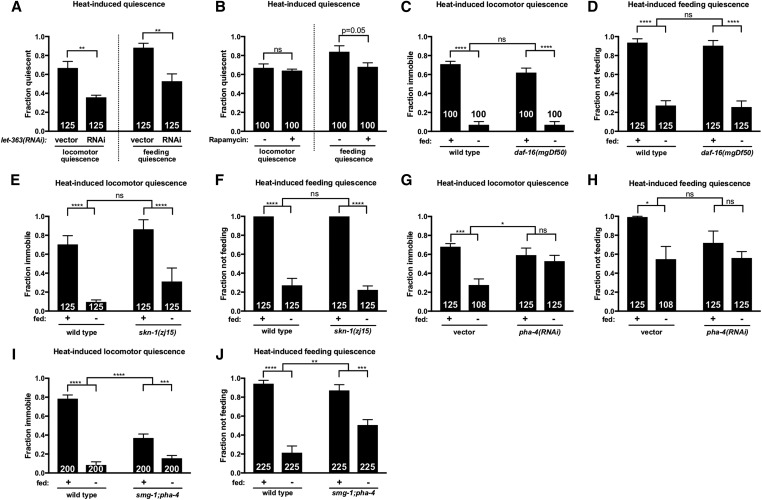Figure 5.
TOR signaling promotes SIS. Animals were heat shocked at 37° for 11 min and examined for locomotor and feeding quiescence (as indicated in each panel) as measures of SIS. (A) LET-363/TOR signaling promotes SIS under well-fed conditions. RNAi-sensitized animals were fed bacteria expressing let-363 dsRNA or an empty vector. (B) Exposure to 200 μM rapamycin for 6 hr impairs feeding quiescence. (C and D) FD suppresses SIS in daf-16 null mutants. (E and F) Animals carrying a hypomorphic mutation in skn-1 show wild-type suppression of sleep in response to FD. (G–J) PHA-4/FOXA is required for starvation-induced sleep suppression. (G and H) Starvation does not significantly suppress heat-induced (G) locomotor or (H) feeding quiescence in pha-4(RNAi) animals, although in the case of feeding quiescence this outcome is not significantly different from vector control (interaction P = 0.16). RNAi-sensitized animals were fed pha-4 dsRNA or an empty vector. (I and J) FD has a significantly reduced effect on heat-induced (I) locomotor and (J) feeding quiescence in pha-4/FOXA mutants. The total number of animals examined is indicated at the bottom of each bar. Error bars represent SEM [25 animals per trial with the exception of (G and H)]. Two-way ANOVA with Sidak’s multiple comparisons test. (See also Figures S6–S8.) *P<0.05, ** P ≤ 0.01, *** P ≤ 0.001, **** P ≤ 0.0001. ns, not significant.

